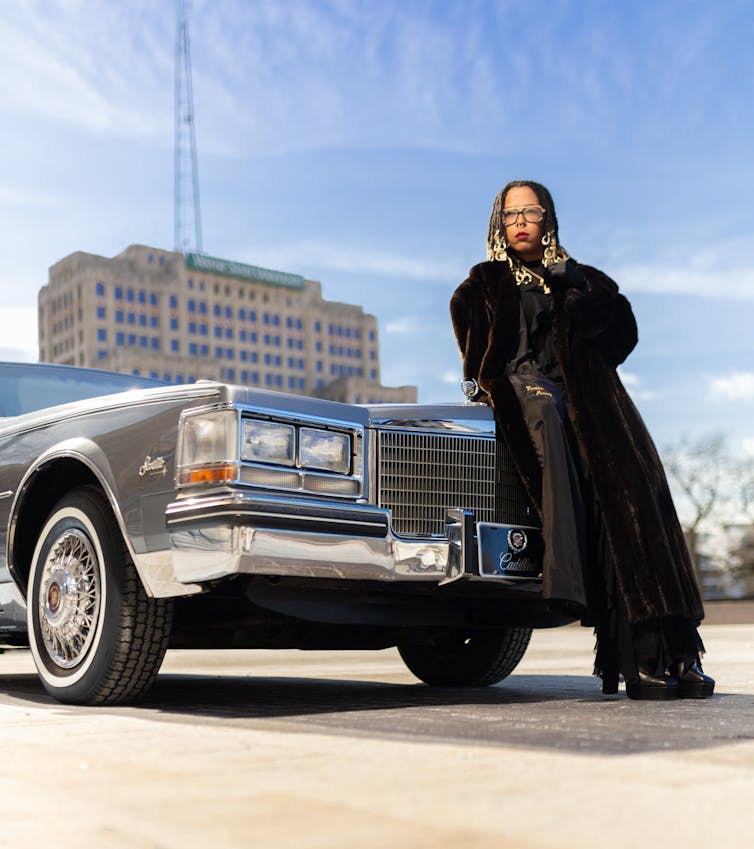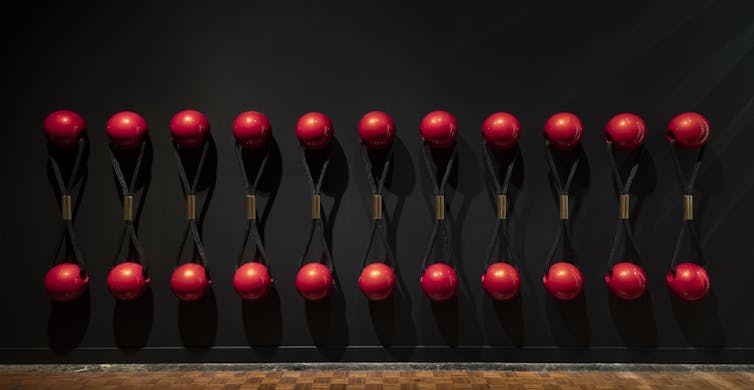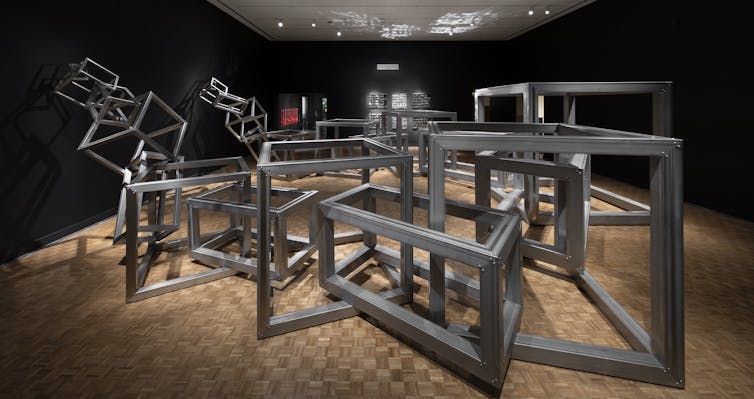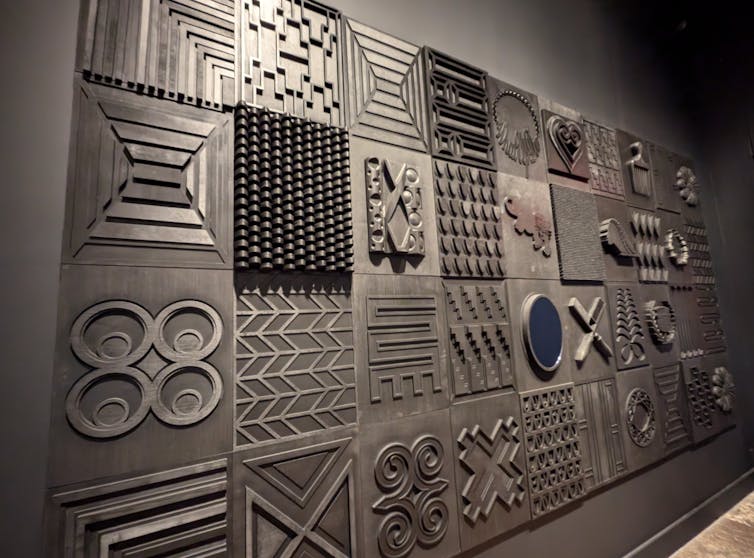Tiff Massey’s ‘7 Mile & Livernois’ Exhibit Is A Tribute To Black Detroit

“7 Mile + Livernois” at the Detroit Institute of Arts celebrates Detroit as a place for Black women to live and create by elevating both the work of the featured artist, Tiff Massey, and the community from which she comes.
The exhibition draws attention to how Detroit is represented in the national – and even global – imagination.
As an art historian who specializes in modern and contemporary art of the African diaspora, I found the exhibition absolutely mesmerizing. I appreciate the ways in which the show recognizes the desire for belonging and self-expression among Black people. I also admire how the show empowers and inspires anyone who visits it.
Named for an avenue of Black fashion
Massey’s exhibition is named for her childhood neighborhood, which is also a vitally important historic, cultural and economic center of Black Detroit.
More popularly known as the Avenue of Fashion because of its many clothiers, the area near the intersection of Seven Mile Road and Livernois Avenue was an epicenter of Black commerce until the 1967 Detroit Rebellion sent shoppers to suburban malls.

The Detroit Institute of Arts
A resurgence of enterprise and an increase in government funding are revitalizing the area by removing abandoned buildings and supporting redevelopment. It’s part of a citywide trend of increased investment and population growth over the past decade or so.
The exhibition poignantly explores the magnificent stylings of previous generations and how Black Detroiters draw from this tradition when they dress and accessorize today.
Throughout history, in many African diasporic communities, dressing in “Sunday’s best” was a way of asserting one’s humanity and dignity. Without question, this exhibition celebrates the importance of this cultural practice.
Monumentalizing the everyday
The exhibition features recent works plus two new sculptures by Massey commissioned by the Detroit Institute of Art. Her new work is juxtaposed with pieces from the museum’s permanent collection.
At the entrance of the exhibition, cubic forms of silver metal are interlinked and attached to the center of the outer wall of the galleries in a sculpture called “Whatupdoe” (2024), which is also a beloved greeting among Detroiters. Even bigger cubic forms emerge from the wall both in square and rectangular shapes and rest on the floor. Resembling a statement necklace, the sculpture occupies much of the gallery space.

Detroit Institute of Art
The change in scale gives it architectural flare, bringing to mind the buildings and houses lining the streets of Detroit, and the many people living both inside and outside the buildings. The conjoined links symbolize the ties that bind the diverse neighborhoods and connect generations of people to the city.
Celebrating the built environment
“I Got Bricks” (2016) consists of serial collections of metallic blocks that are shaped like gemstones set into jewelry. The six clusters of glistening slabs echo the shapes of bricks used to build early to mid-20th century architectural structures, but are presented in geometric and varied arrangements.
The work speaks again to the notion of seeing oneself in the built environment. “I Got Bricks” suggests that neighborhoods once viewed disparagingly can be seen as sites of beauty that reflect the histories of many African American families who overcame great odds and led extraordinary lives.
“Quilt Code 6 (All Black Everything)” (2023) is a gorgeous wooden installation painted in black that encompasses iconography and design motifs from the city, as well as the artist’s archive. An Afro comb, the Cadillac logo, a pair of hot combs, the Black Panther Party logo, an Adinkra symbol, and design motifs found on building facades are some of the imagery featured on this work.

The Conversation/Monica Williams, CC BY-ND
It’s positioned near mid-century sculptor, Louise Nevelson’s “Homage to the World” (1966), which also is painted black but features detritus from the streets of New York City. This juxtaposition highlights how both works employ similar compositions to convey two different worldviews, one of a African American woman born in the late 20th century and the other of a European American woman born in the late 19th century.
“I’ve Got Bundles and I Got Flewed Out (Green)” (2023) is a similar installation with an array of green and yellow hairpieces of varying textures and styles displayed on a black-hued background. The theme of artifice as integral to the beauty rituals of Black women comes to mind.
The objects conveyed in “I Remember Way Back When” (2023) and “Baby Bling” (2023) are easily identifiable for many Black women and other women of color, particularly those who were children in the 1970s and ‘80s.
The former depicts barrettes, while the latter features hair elastics with balls on each end. The 11 enlarged objects in both works are painted in stunning red and arranged horizontally, literally making a big deal of how Black girls present themselves to the world.
These nostalgic works are juxtaposed with minimalist artist Donald Judd’s vertically rendered “Stack” (1969), which uses a series of green rectangular forms to bring to mind modernist architecture.
Making art in the Motor City
Metalsmithing is closely tied to Detroit’s reign as a mecca of industry in the early 20th century. During that period, the city gained a labor force of African Americans fleeing the South, as well as immigrants from Europe, the Middle East and even Latin America and the Caribbean.
In “Fulani” (2021), “39 Reasons I am not Playing” (2018) and “Everyday Arsenal” (2018), Massey adeptly reveals how the everyday objects of self-adornment celebrated in the show share a history with the metalsmithing of the automobile industry in the Motor City.

The galleries filled with Massey’s work invite viewers to pay more attention to everyday objects and the built environment that surrounds us.
“7 Mile and Livernois” runs at the Detroit Institute of Arts through May 11, 2025. Admission is free for residents of Wayne, Oakland and Macomb counties.![]() Samantha Noël, Associate Professor of Art History, Wayne State University
Samantha Noël, Associate Professor of Art History, Wayne State University
This article is republished from The Conversation under a Creative Commons license.![]()
SEE ALSO:
Understanding Detroit’s Legacy Of Discriminatory Housing Practices
What Is Redlining And How Can It Be Solved?


Post a Comment
0 Comments